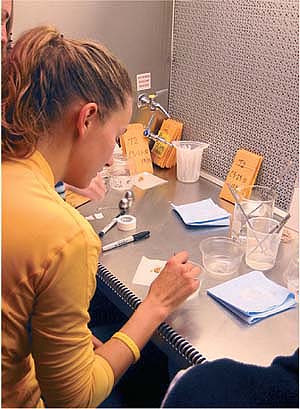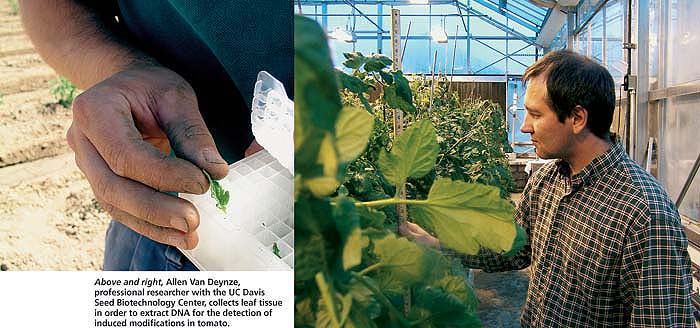All Issues
Timeline uncertain for agricultural biotechnology
Publication Information
California Agriculture 60(3):114-115.
Published July 01, 2006
PDF | Citation | Permissions
NALT Keywords
Full text
With the identification of deoxyribonucleic acid (DNA) as the basis for genetic inheritance in 1953, and the recognition that its simple chemical language of nucleotides — A's, C's, G's and T's — was responsible for life's abundant forms, scientists began unraveling the mysteries of genetic inheritance. This discovery formed the basis for the development of recombinant DNA (rDNA) methods, first reported in 1973 by California scientists Stanley Cohen and Herbert Boyer. They demonstrated that it was possible to move functional segments of DNA from one organism to an unrelated organism — a technique commonly called genetic engineering or biotechnology.
Editor's note: Examining biotechnology's risks and benefits
The power of genetic manipulation first became apparent in the mid-1800s, when Gregor Mendel established the rules of inheritance through painstaking experiments with garden peas. Soon after, California's Luther Burbank extended his findings by breeding more than 800 varieties of fruits, flowers, vegetables, grains and grasses. The new understanding of genetics, combined with landmark discoveries at the molecular level, laid the groundwork for genetic engineering. In the Outlook at right, Peggy Lemaux takes stock of the current prospects for this technology in California agriculture.
In the peer-reviewed articles that follow (pages 116 to 139), California Agriculture launches a special series on the risks and benefits of biotechnology in agriculture: “When transgenes wander, should we worry?”
We previously covered the obstacles facing horticultural biotechnology (“Fruits of biotechnology struggle to emerge,” April-June 2004) and biotechnology's promise (“On the horizon: Agriculture's new millennium,” July-August 2000). In our judgment, the risk-benefit picture for biotechnology merits equally careful attention in this special series.
Authors in the current issue consider transgenes in crop plants, fish and animals; future articles will examine genetically modified insects, pharmaceutical plants and rice. Your thoughts and comments on this series are welcome; please write to calag@ucop.edu.
The first use of genetic engineering to modify plants was reported in tobacco in 1983, and the first commercial genetically engineered plant, the FlavrSavr tomato, was marketed in 1994 by a California company, Calgene (California Agriculture 54[4]:6–7). Although the tomato was later taken off the market, other commercialized crops have entered — most notably large-acreage crops such as canola, corn, cotton, soy and most recently alfalfa. A few minor-acreage crops have met with limited commercial success: papaya, certain types of squash and sweet corn.
However, if success were measured by the increase in global acreage of these crops, certainly genetically engineered crops have been successful; in 2005, the billionth acre was planted. About 8.5 million farmers in 21 countries have carried out the planting, although most of the acreage was in the United States, with almost none in Europe (James 2005). Acceptance by consumers has not come so easily, and the majority are still not aware that they are eating genetically engineered foods (Pew Initiative on Food and Biotechnology 2006; (James 2004).
Despite the acreage devoted to genetically engineered crops, the diversity of crops and traits is limited. Nearly all commercial, genetically engineered crops are either those which carry pest-killing genes from the bacterium Bacillus thuringiensis (Bt), or those carrying herbicide tolerance, predominantly to Monsanto's glyphosate (Roundup) herbicide. In addition, with the exception of genetically engineered papaya, which was developed by public-sector scientists, all commercial varieties on the market in 2006 came from the private sector (California Agriculture 58 [2]).
Above and right, Allen Van Deynze, professional researcher with the UC Davis Seed Biotechnology Center, collects leaf tissue in order to extract DNA for the detection of induced modifications in tomato.
The insecticidal and herbicide-tolerant traits are focused on improving the lot of the farmer. But, if used responsibly, some scientists believe that these improvements can also be beneficial to the environment. This has been most dramatically demonstrated by the decreases in insecticide application since the cultivation of Bt cotton (Sankula et al. 2005; Benbrook 2004). Estimates of whether herbicide use has increased or decreased vary depending on the crop, location and calculation method used, but the types of herbicides being used and the ease of use has resulted in a shift to more environmentally friendly herbicides (Fernando-Cornejo and McBride 2002).
A look down the pipeline for future applications of biotechnology for agricultural crops is clouded by a number of factors. Although public-sector scientists have played a role in variety development, their ability to do so in the arena of genetically engineered crops is limited by issues such as regulatory costs and inadequate access to key technologies due to intellectual-property protections (patented technologies and genes). These factors, as well as consumer acceptance, will determine whether genetic technologies will be used to address problems specific to the small-acreage crops important to California.
Responding to the impact of these obstacles, crop biotechnology is adding a new chapter. A UC-based initiative called Public Intellectual Property for Research in Agriculture (PIPRA) is creating a public-sector “toolbox” through an intellectual-property consortium that is focused on identifying enabling technologies that will overcome some of the existing constraints (Graff et al. 2004). Also, the national group Specialty Crops Regulatory Initiative (SCRI), with strong California representation, is leading an effort to ease small-market and specialty genetically-engineered crops through the costly regulatory-approval processes. With these factors playing a role, perhaps the promise of biotechnology for California's small-acreage crops will be realized.
For more information:
PIPRA: www.pipra.org
SCRI: www.csrees.usda.gov/nea/biotech/part/biotechnology_part_specialty.html
UC Statewide Biotechnology Workgroup:






